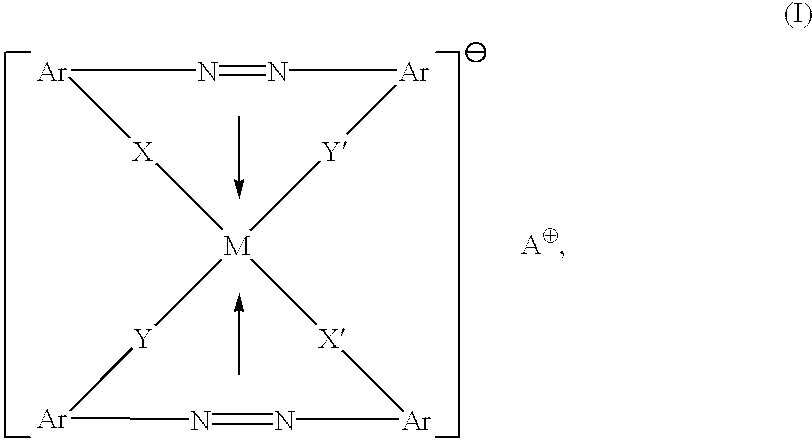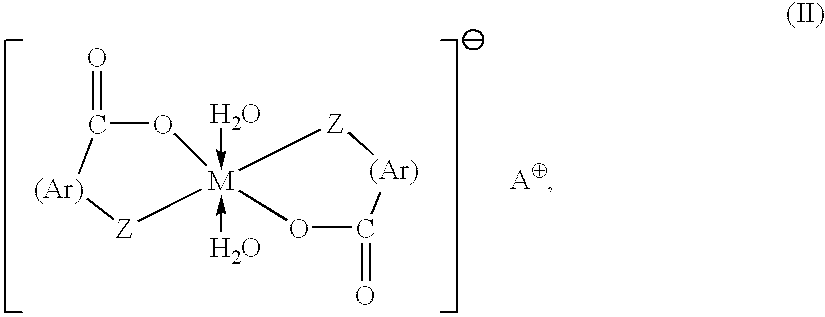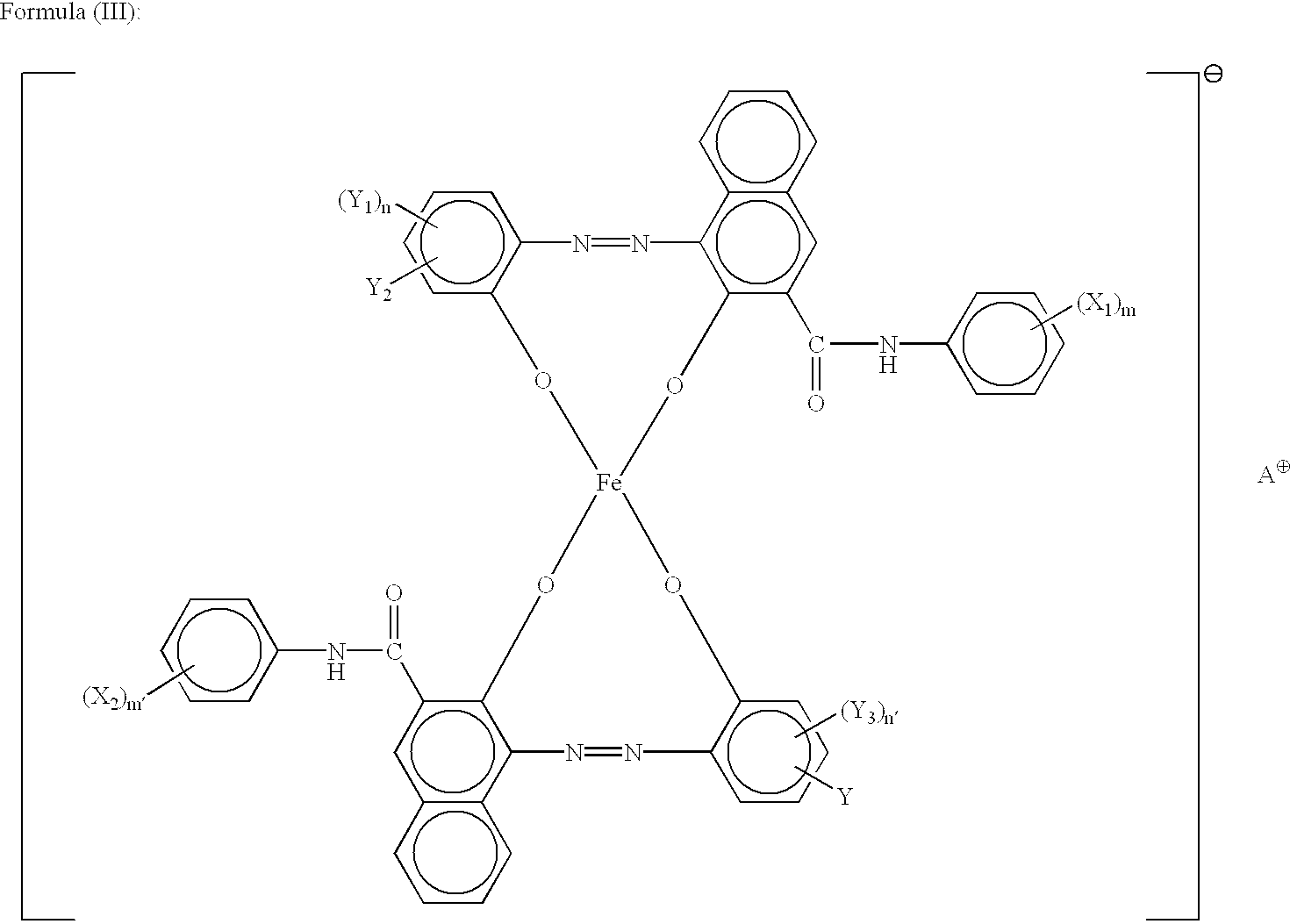A toner having D4>12 .mu.m may be obtained by reducing the energy input to the
pulverizer to the minimum or increasing the feed rate, but the resultant toner particles are liable to be angular,so that it becomes difficult to attain desired circularity level and circularity distribution.
A toner having D4<5 .mu.m may be obtained by increasing the energy input to the
pulverizer or reducing the feed rate to the minimum, the resultant toner particles are caused to have a particle shape approximate to a sphere, and it becomes difficult to attain desired circularity level and circularity distribution.
A toner having containing more than 25% by number of particles having a particle size of at least 10.1 .mu.m may be obtained by reducing the energy input to the pulverizer to the minimum or increasing the feed rate, but the resultant toner particles are liable to be angular,so that it becomes difficult to attain desired circularity level and circularity distribution.
If the binder resin does not have an
acid value in the above-described range, the dispersion of toner ingredients, particularly magnetic iron
oxide particles, within the binder resin in the step of melt-kneading is liable to be inferior, so that the amount of the isolated magnetic iron
oxide particles is liable to be increased in the pulverization step.
Further, if the
acid value of the binder resin is below 1 mgKOH / g, the resultant toner particles are liable to have a lower chargeability, thus providing a toner with lower developing performance and stability in continuous
image formation.
On the other hand, above 100 mgKOH / g, the binder is liable to be excessively
moisture-absorptive, to provide a toner resulting in a lower
image density and increased
fog.
If the main peak molecular weight (Mp) is below 2,000, it is difficult for the toner to have an appropriate level of elasticity modulus, so that the toner is liable to have inferior continuous image forming performance while the fixability is increased.
More specifically, on
continuation of
image formation, the magnetic iron oxide particles are liable to drop off from the toner particles, thus resulting in a lower developing performance.
If Mp exceeds 25,000, the toner is liable to show a lower fixing performance.
A resin not having such Mp fails to exhibit an appropriate level of elasticity modulus, thus failing to cause an appropriate level of shearing force at the time of melt-kneading for toner production, so that the dispersibility of the toner ingredients is lowered and the magnetic iron oxide particles are liable to be isolated from the toner particles.
Further, as the dispersion of the toner ingredients is lowered, the resultant toner is liable to have lower fixability and stability in continuous image formation.
If Tg of the toner is below 45.degree. C., the toner is liable to be deteriorated in a high temperature environment and liable to cause offset at the time of fixation.
On the other hand, if Tg of the toner exceeds 75.degree. C., the toner is liable to exhibit a lower fixability.
If the content is below the above-mentioned range, the addition effect thereof is scarce, thus failing to provide better dispersibility and charging uniformity.
In excess of the above range, the resultant magnetic iron oxide particles are liable to cause excessive charge liberation to result in an insufficient chargeability, thus causing a lower
image density and increased
fog.
The presence of many adsorption sites not allowing easy liberation of adsorbed water results in a magnetic toner (containing the magnetic iron oxide particles) which exhibits a lower chargeability and takes much time in
recovery of chargeability, particularly after long-term standing in a high-
humidity environment.
More specifically, in a case of y>2.06x-7.341 showing a broad
particle size distribution, the toner particles are liable to have a fluctuation in charge distribution, leading to an inferior performance in continuous image formation.
On the other hand, a case of y<2.06x-9.113 represents a very narrow particle size distribution, and in such a case, the toner is provided with a very uniform charge and shows an improved developing performance, but the toner amount effectively used for development is liable to be increased thus resulting in rather undesirable image qualities, such as a broader
line width and a lower dot reproducibility.
Moreover, a toner having such a very narrow particle size distribution requires a severe classification step control, resulting in larger amounts of
fine powder fraction and coarse powder fraction leading to a
lower yield of the toner product.
Below 65.degree. C., the anti-blocking property of the toner is lowered, and above 160.degree. C., it is difficult to attain the anti-offset effect.
As a result, the uniform conveyance of the magnetic toner to the developing sleeve becomes difficult, and the magnetic toner ununiformly covering the developing sleeve is liable to be ununiformly charged to result in image irregularity.
Further, if the magnetic toner shows a floodability index of 80 or below and a flowability index of 60 or below, the magnetic toner particles are liable to
agglomerate with each other and cause melt-sticking of the magnetic toner at the sliding parts in the
cartridge.
If the magnetic toner has an absolute value of triboelectric chargeability .vertline.Qd.vertline. with respect to
iron powder carrier exceeding 70 .mu.c / g, the magnetic toner is liable to cause a lowering in developing performance due to excessive charge particularly in a low
humidity environment.
On the other hand, if .vertline.Qd.vertline.<20 .mu.C / g, because of a lower chargeability, the magnetic toner on the developing sleeve is liable to fail in acquiring an appropriate level of electrostatic agglomeration force and an appropriate level of magnetic constraint force, thus failing to achieve a faithful transfer onto an electrostatic
latent image and thus showing a lower developing performance.
If the absorption peak
temperature difference (.vertline.Tabs.max-Tabs.2nd.vertline.) is below 20.degree. C., it becomes difficult to realize the functional separation.
Further, the resultant toner particles are made indefinitely and angularly shaped, so that the magnetic iron oxide particles are liable to fall off the toner particles.
Such toner particles produced through the impingement-type pneumatic pulverizer ca be subjected to modification of particle shape and surface property for reducing the liberatability of magnetic iron oxide particles from the toner particles by application of
mechanical impact (as by using a hybridizer), but the difficulties arising from the magnetic iron oxide particles liberated from the toner particles at the time of the impingement cannot be recovered thereby, so that the control of the toner shape and the number of isolated magnetic iron oxide particles is more difficult compared with the toner production process using a mechanical pulverizer.
A
temperature difference .
DELTA.T of below 30.degree. C. suggests a possibility of short pass of the powdery feed without effective pulverization thereof, thus being undesirable in view of the toner performances.
On the other hand, .
DELTA.T>80.degree. C. suggests a possibility of the overpulverization, resulting in the liberation of magnetic iron oxide particles from and surface deterioration due to heat of the toner particles and melt-sticking of toner particles onto the apparatus wall and thus adversely affecting the toner productivity.
A circumferential speed below 80 m / s of the rotor 314 is liable to cause a short pass without pulverization of the feed, thus resulting in inferior toner performances.
A circumferential speed exceeding 180 m / s of the rotor invites an overload of the apparatus and is liable to cause overpulverization resulting in the isolation of magnetic iron oxide particles.
Further, the overpulverization is also liable to result in surface deterioration of toner particles due to heat, particularly the liberation of magnetic iron oxide particles at the toner particle surfaces, and also melt-sticking of the toner particles onto the apparatus wall, thus adversely affecting the toner productivity.
A gap exceeding 10.0 mm between the rotor 314 and the
stator 310 is liable to cause a short pass without pulverization of the powdery feed, thus adversely affecting the toner performance.
A gap smaller than 0.5 mm invites an overload of the apparatus and is liable to cause overpulverization resulting in the isolation of magnetic iron oxide particles.
Further, the overpulverization is also liable to result in surface deterioration of toner particles due to heat, particularly the liberation of magnetic iron oxide particles at the toner particle surfaces, and also melt-sticking of the toner particles onto the apparatus wall, thus adversely affecting the toner productivity.
If Ra>10.0 .mu.m, Ry>60.0 .mu.m or Rz>40.0 .mu.m, overpulverization is liable to occur at the time of pulverization, and the overpulverization is liable to result in surface deterioration of toner particles due to heat, particularly the isolation of magnetic iron oxide particles at the toner particle surfaces, and also melt-sticking of toner particles onto the apparatus wall, thus adversely affecting the toner productivity.
The effective pulverization achieved by the above-mentioned mechanical pulverizer allows the omission of a pre-classification step liable to result in overpulverization and omission of the large-volume pulverization air supply required in the pneumatic pulverizer as used in the
system of FIG. 8.
 Login to View More
Login to View More  Login to View More
Login to View More 


